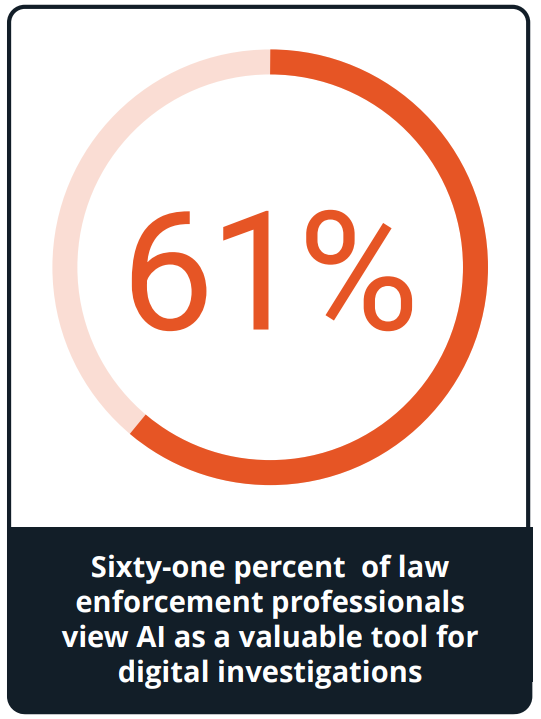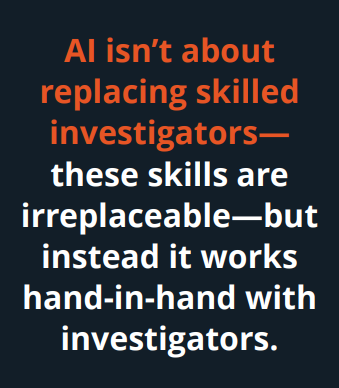
Artificial intelligence (AI) is rapidly changing the way we work and live. We’re already seeing its profound impact across industries and in daily life. AI’s ability to empower people, increase efficiency and deliver on-demand insights continues to grow as the technology accelerates.
Law enforcement is one of the sectors where AI is starting to make a significant impact, especially in digital forensics and investigations. Sixty-one percent of law enforcement professionals view AI as a valuable tool for digital investigations, highlighting improved efficiency, increased accuracy and the ability to uncover hidden evidence as key drivers.
This whitepaper examines the role and future…

Artificial intelligence (AI) is rapidly changing the way we work and live. We’re already seeing its profound impact across industries and in daily life. AI’s ability to empower people, increase efficiency and deliver on-demand insights continues to grow as the technology accelerates.
Law enforcement is one of the sectors where AI is starting to make a significant impact, especially in digital forensics and investigations. Sixty-one percent of law enforcement professionals view AI as a valuable tool for digital investigations, highlighting improved efficiency, increased accuracy and the ability to uncover hidden evidence as key drivers.
This whitepaper examines the role and future potential of AI in digital forensics and investigations, identifying key digital investigation challenges in public safety, law enforcement, federal agencies and enterprises—and how AI can help address these challenges. It also explores Cellebrite’s AI strategy, the AI capabilities we’re already delivering and the real- world results our customers are seeing.
Global Challenges in Digital Investigations
Law enforcement agencies are struggling with the complexity and volume of digital investigations. More and more, crimes now involve digital devices, and the vast amount of digital data is overwhelming. It’s no longer just about text messages, emails or call logs. Modern devices store many gigabytes of information, including images, videos, location data, browser histories and files from dozens of apps. Sifting through this data—let alone connecting the dots—is incredibly time-consuming. In fact, a recent Cellebrite survey of more than 2,000 law enforcement professionals revealed that 69% of investigators don’t have enough time to review all the digital evidence in their cases. Backlogs are also common, often lasting three to four weeks.

Simply adding more resources isn’t always possible, nor is it the answer. Public safety agencies have limited budgets, and with ongoing scrutiny of how public money is spent, it can be difficult to ramp up digital investigation capacity. Even if budgets were available, digital forensics and investigation skills require specialized training. Becoming an effective technician or investigator takes years of education and experience. This leaves many law enforcement agencies without an obvious solution and weighs heavily on the justice system, leading to potential delays, frustration and loss of trust.
It’s not just about a lack of time and resources. The complexity and interconnected nature of digital data make it easy to miss critical evidence. There are some things that humans cannot easily detect. For instance, what are the communications patterns between suspects—not just the network, but also changes in the frequency and nature of communications leading up to a crime? Or, as a much simpler example, keyword searches that miss weapons because guns are referred to as “glizzies” or a codeword. These gaps decrease the quality of investigations and can lead to poorer judicial outcomes. It would take a huge amount of human resources to close these gaps.
The Benefits of AI
AI has the ability to break this logjam, and forward- thinking public safety organizations are already turning this potential into reality. AI isn’t about replacing skilled investigators—these skills are irreplaceable—but instead it works hand-in-hand with investigators to unlock a broad range of benefits, including vastly enhanced productivity and insights.
Here are two key tangible benefits:
Increased efficiency
AI can sift through enormous volumes of raw data to uncover potential evidence. That means investigators can spend their valuable time evaluating evidence, rather than hunting through gigabytes of irrelevant information. One simple example is image classification, where AI examines images on a device, identifying things like weapons, vehicles or even images of potential child abuse. By surfacing this type of data, AI radically reduces the volume of information that needs to be analyzed, while still giving investigators full oversight and control.
AI can also significantly reduce the administrative overhead for investigators. For example, investigators typically spend three or four hours preparing a warrant. AI can draft warrants in seconds, giving investigators a starting point they can review and adjust as needed. Again, this isn’t about AI replacing human experts—it’s about automating repetitive tasks under the full oversight and control of investigators.
Increased effectiveness
At its most basic, AI helps surface hidden evidence, ensuring the most complete picture possible. Things like automated image classification make sure that examiners, analysts and investigators can evaluate all relevant evidence rather than just sampling due to time constraints. But it’s also broader than that. The technology helps uncover information in a consistent way, every time, which reduces the risk of overlooked evidence. We talked about one example previously— detecting changing communications patterns.

However, there are many others, such as establishing identities across multiple accounts and devices or identifying similar faces across thousands of images. All of these bolster the quality of investigations, especially since investigators now have the time to evaluate this expanded evidence.
Cellebrite’s AI Strategy
As a world leader in digital forensic and investigative solutions, Cellebrite is committed to unlocking the benefits of AI for our customers. We have been innovating with AI since 2016 and have already rolled out a rich set of AI capabilities. Now, we have embarked on a comprehensive three-stage AI strategy. This strategy is designed to drive continuous AI innovation which will empower investigators, accelerate investigations and deliver better case outcomes. These three stages include:
Enhancement
In this initial phase, our goal is to deliver fast time to value by using AI to enhance the Cellebrite capabilities our customers already use today. The goal is to make these capabilities work faster and smarter, with a specific focus on quickly surfacing evidence from existing data sets. By delivering AI-powered capabilities such as chat summarization , we are empowering investigators with potential evidence that they can examine and validate, rather than spending their time wading through huge volumes of largely irrelevant data. More information on current Cellebrite AI -powered capabilities and a roadmap is included later in this document.
Differentiation
As we continue to enhance existing product capabilities, we continue to invest in areas that set us apart. Our goal is to create solutions that address unmet needs and radically accelerate digital investigations. This includes automating repetitive tasks, such as creating reports and verifying information. We will also introduce advanced capabilities, such as AI-powered video review and analysis, saving many hours of investigation time. At the same time, we will promote AI adoption by ensuring that our AI solutions meet all regulatory requirements and adhere to principles of ethical, transparent and trustworthy use, fostering confidence among users and stakeholders.
Transformation
Increasing levels of cybercrime are generating an explosion of digital evidence and data. AI can turn this data into actionable intelligence, providing deep insights that allow investigators to make the best use of their critical-thinking and decision- making skills. In our transformation phase, we will invest in research to identify and implement the most promising advanced AI analytics capabilities. Potential areas of research include decoding and analyzing complex data sets to uncover evidence, automatically reconstructing digital timelines and connections, providing interactive AI agents to interrogate digital data, and extending data coverage to a holistic set of sources, including mobile devices, social media platforms, cloud services and IoT devices.
AI in Cellebrite Solutions
Cellebrite has already delivered a rich set of AI capabilities that enhance our existing products, dramatically increasing the efficiency and quality of digital investigations. These AI capabilities, which are always verified by the user, include:
Visual content
- **Image categorization: **Automated categorization of video and images into predefined categories such as drugs, weapons, credit cards, nudity, screenshots, documents and more
- Image similarity: Analysis of images for similar visual elements, such as symbols, rooms and backgrounds
- Face similarity: Enhancement of images containing a human face and presentation of additional images with human faces for comparison
- Video summarization: Generation of video previews showing essential information highlights from original footage
- **Image OCR: **Extraction of text from images, making it easier to search for and analyze relevant information
Text content
- **Topic detection: **Extraction of main subjects from text and grouping into categories such as money and drugs, facilitating content classification
- **Chat relationship classification: **Analysis of chat interactions to identify potential relationships, shared interests and other common discussion topics among participants
- **Chat summarization: **Summarization of chat messages to provide concise overviews of lengthy conversations
- **Language detection and translation: **Automatic identification of text language and conversion into other languages, enabling accurate review and analysis of foreign-language communications
Audio content
- **Speech to text: **Conversion of speech from audio and video into written text, simplifying transcription and analysis
- **Audio classification: **Division of audio into segments and classification of each segment into categories such as regular speech, shouting, crying, explosions and other categories
Other
- **App classification: **Automated assignment of apps to predefined categories based on services and content, such as chat, spoofing, cryptocurrency and other types of apps
- URL classification: Categorization of web addresses based on content and site purpose
- Entity extraction: Categorization of key elements such as names, people, organizations and other types of entities
- **Person resolution: **Identification and resolution of multiple identifiers, such as email addresses and phone numbers, to a single person or entity
Cellebrite continues to grow these AI capabilities even further, continuously increasing the value we deliver to customers. Examples of upcoming innovations include:
- **Agentic AI **works like having a team of digital analysts at your fingertips. These AI-powered assistants can be trained to focus on specific types of data, follow investigative instructions and help answer case-related questions. They support investigators by handling routine tasks and surfacing useful information, so teams can stay focused on what matters most.
- Conversational Evidence Querying enables investigators to interact with evidence using natural language. Instead of manually applying filters, they ask questions such as “Is there any indication that the device owner has engaged in criminal behavior involving guns?” and quickly retrieve the most relevant results across data sources.
- Synthetic media detection, allowing investigators to automatically detect deep fakes and other types of synthetic media.
Cellebrite AI-Capabilities in Action
Cellebrite’s AI capabilities are already delivering positive outcomes for customers, accelerating investigations and leading to better outcomes. Here are several examples:
Tackling
child sexual abuse material
In Connecticut, Cellebrite’s AI capabilities played a crucial role in a child sexual exploitation case. The suspect had 35 terabytes of data spread across 50 devices, and manually reviewing this vast amount of data could have taken months, delaying the investigation and potentially compromising critical outcomes. Investigators used Cellebrite’s AI-powered solutions to rapidly analyze the data, flagging victim imagery and explicit material. This dramatically sped up the investigative process while reducing the psychological burden this type of investigation typically places on officers. AI helped lead to the rapid discovery of 20 child sexual abuse material videos and 17,000 images of child erotica. Ultimately, the offender was sentenced to more than 12 years in prison.
Dismantling a transnational criminal organization
AI has also proven invaluable in combating organized crime on a global scale. One example comes from a federal police force in South America working to disrupt the operations of an international drug cartel. Rather than focusing on intercepting drug shipments involving low-level operatives, police used AI tools within Cellebrite’s solutions to follow financial trails and seize assets owned by the cartel kingpins. Investigators extracted and analyzed data from seized digital devices, quickly uncovering key connections between suspects, bank accounts and physical assets. This led to international cooperation across multiple countries to dismantle the cartel’s financial infrastructure, the arrest of 45 individuals and the seizure of $400 million worth of assets.
Accelerating time to
resolution for IP theft cases
Intellectual Property (IP) theft is widespread. One key reason is that data can be captured and transferred easily using cloud syncing and other fast data transfer methods. Every organization, no matter its size, can suddenly find its proprietary technology in the hands of a competitor simply because an employee transferred sensitive information. Cellebrite AI-powered capabilities around media classification help enterprises uncover evidence faster than ever, so they accelerate investigations, saving valuable time and resources. By using AI to quickly scan for media such as relevant screenshots and key documents pertaining to the investigation, organizations can act swiftly and efficiently mitigate the impact of IP theft.

The Bottom Line
Modern digital investigations face immense challenges. Caseloads are increasing, and the sheer volume of data that needs to be analyzed is often enormous. Investigators are struggling to keep up and face overwhelming workloads and limited budgets. At the same time, given the increasingly complex, interconnected nature of digital data, critical evidence and patterns can easily be missed, especially when comparing and correlating across data sources.

AI can help address these challenges by working hand-in-hand with investigators, surfacing potential evidence for further analysis and automating time-intensive tasks. As a result, investigators can make the best use of their skills while letting AI automate mundane, high-volume work. This accelerates investigations, improves investigation quality and leads to better judicial outcomes.
As a global leader in digital forensics, Cellebrite is unleashing the value of AI for our customers. We have already introduced a rich set of AI capabilities in the Cellebrite platform, and we’re aggressively pursuing a strategy that delivers quick wins and transformative long-term innovation. That strategy is already bearing fruit today for Cellebrite customers, delivering real-world results across multiple types of investigations.
To learn more about how AI tools within Cellebrite’s solutions can impact your digital investigations, visit https://cellebrite.com/en/ai-center/